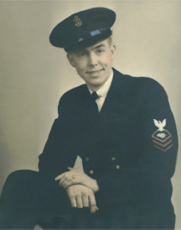

VT4 men on board aircraft carrier USS Ranger (CV-4) -- 1 October 1943
3 days before Operation "Leader"
[National Archives Photo]
USS CORRY (DD-463) PHOTOS
Operation "Leader" - The Raid on Bodo, Norway
|
On October 4, 1943, as part of Operation "Leader" the USS Corry provided escort support for the aircraft carrier USS Ranger (CV-4) battle group in the highly successful Allied air raid on the area around German-occupied Bodo, Norway. Bodo is a small coastal town located about 100 miles north of the Arctic Circle. After escorting the Ranger, the Corry had the additional job of moving closer toward land so as to rescue any American pilots that might not make it back all the way. German shipping and a radar-communications installation were destroyed by pilots from the Ranger. |


VT4 men on board aircraft carrier USS Ranger (CV-4) -- 1 October 1943
3 days before Operation "Leader"
[National Archives Photo]

VB4 men on board aircraft carrier USS Ranger shortly before Operation Leader
(Northern Attack Group)
- C.O. LCMDR. Klinsmann (in the middle in front row)
- LT (jg) Tucker - Killed over Bodo Harbor - No. 8 from left in back row
[National Archives Photo]

Attack planes from USS Ranger during Operation "Leader"
4 October 1943. [National Archives Photo]

View from attack plane from USS Ranger
during Operation "Leader"
[National Archives Photo]

SBD's (VB4) and F4F's (VB4) in coordinated attack over
Bodo Harbor -- Northern Attack Group.
4 October 1943, approx. 0800 AM.
[National Archives Photo]

Air attack at Bodo harbor.
[National Archives Photo]
BELOW:
Path of USS Ranger task force from Scapa Flow, Scotland
to Norway to point of Bodo air attack.

BELOW:
Close-up path of aircraft attack on Bodo from aircraft carrier USS Ranger.
Note names of at least 15 ships sunk / destroyed / damaged in four locations
as well as location of German JU-88 patrol aircraft shot down (top left, near Ranger).
N.A.G. = Northern Attack Group; S.A.G. = Southern Attack Group

 |
OCT. 1943 BATTLE / DAMAGE REPORTS: Click here to view Operation Leader Battle / Damage Reports including names of ships attacked |
BELOW:
USS Corry Chief Petty Officer "Mac" McKernon's
First-hand account of Operation "Leader" Bodo Raid
With more National Archives Photos

USS Corry (DD-463)
Chief Radio Technician
Francis "Mac" McKernon
|
THE MIRACLE SNOWSTORM (OPERATION "LEADER")
After 9:00 a.m., attack aircraft were returning to the carrier. Although we lost only a few of our planes in the raid, some of the ones that made it back were all shot up. After the last attack aircraft had landed on the Ranger, a German JU-88 patrol plane came by. Spotting an aircraft carrier task force, the German pilot knew that the U.S. planes were not coming from Russia but from off the coast. American fighters that were in the air guarding the Ranger immediately went after the German plane and shot it down. I remember watching the long black trail of smoke pouring out of the plane before it crashed about a mile away from the Corry. However, on the Corry’s radio, we heard the pilot shouting in German just before he got hit. He was telling his superiors, who had sent their planes toward Russia, “You clowns! They’re all right out here! Just off the coast!”
Because he had given away our location, we knew German planes would soon come after us. The admiral promptly gave the order for the task force to move out. It was more than 700 miles back to Scapa Flow, Scotland—plenty of distance for the Nazis to catch up to us. We were sure that quite a bit of shooting would soon commence, bringing many potential casualties. |
Below: Following the completion of the raid, USS Corry crewmembers
were given certificates showing that they had crossed the Arctic Circle
aboard the Corry while en route to Bodo.

Mac McKernon's Arctic Circle Certificate

Bill Finch's Arctic Circle Certificate
Contact: webmaster @ uss-corry-dd463.com
USS Corry DD-463 home page